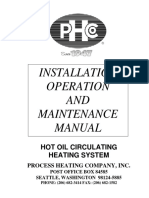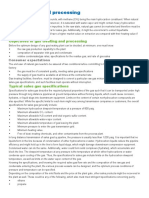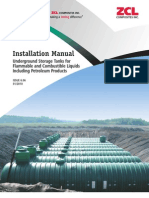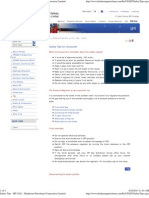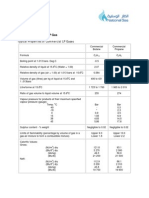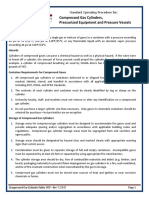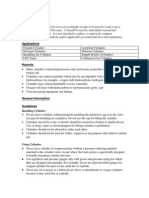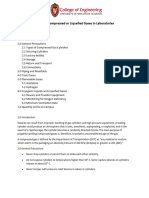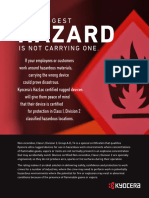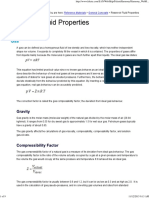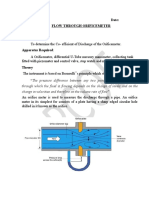0 ratings0% found this document useful (0 votes)
141 viewsGas Cylinder Rules
Gas Cylinder Rules
Uploaded by
Anuj SinhaThe document outlines rules pertaining to the filling, storage, handling and transportation of gas cylinders exceeding a pressure of 1.5kg/cm2 at 15 degrees Celsius. It regulates the manufacture, marking, testing and inspection of gas cylinders. It defines key terms and specifies identification colors, storage requirements, safety devices, purity standards, and procedures for cylinders exposed to fire or leaks.
Copyright:
© All Rights Reserved
Available Formats
Download as PPTX, PDF, TXT or read online from Scribd
Gas Cylinder Rules
Gas Cylinder Rules
Uploaded by
Anuj Sinha0 ratings0% found this document useful (0 votes)
141 views24 pagesThe document outlines rules pertaining to the filling, storage, handling and transportation of gas cylinders exceeding a pressure of 1.5kg/cm2 at 15 degrees Celsius. It regulates the manufacture, marking, testing and inspection of gas cylinders. It defines key terms and specifies identification colors, storage requirements, safety devices, purity standards, and procedures for cylinders exposed to fire or leaks.
Copyright
© © All Rights Reserved
Available Formats
PPTX, PDF, TXT or read online from Scribd
Share this document
Did you find this document useful?
Is this content inappropriate?
The document outlines rules pertaining to the filling, storage, handling and transportation of gas cylinders exceeding a pressure of 1.5kg/cm2 at 15 degrees Celsius. It regulates the manufacture, marking, testing and inspection of gas cylinders. It defines key terms and specifies identification colors, storage requirements, safety devices, purity standards, and procedures for cylinders exposed to fire or leaks.
Copyright:
© All Rights Reserved
Available Formats
Download as PPTX, PDF, TXT or read online from Scribd
Download as pptx, pdf, or txt
0 ratings0% found this document useful (0 votes)
141 views24 pagesGas Cylinder Rules
Gas Cylinder Rules
Uploaded by
Anuj SinhaThe document outlines rules pertaining to the filling, storage, handling and transportation of gas cylinders exceeding a pressure of 1.5kg/cm2 at 15 degrees Celsius. It regulates the manufacture, marking, testing and inspection of gas cylinders. It defines key terms and specifies identification colors, storage requirements, safety devices, purity standards, and procedures for cylinders exposed to fire or leaks.
Copyright:
© All Rights Reserved
Available Formats
Download as PPTX, PDF, TXT or read online from Scribd
Download as pptx, pdf, or txt
You are on page 1of 24
THE GAS CYLINDER RULES, 1981
The provisions of these rules pertain to the filling.
Storage, handling and transportation of gas cylinders
exceeding pressure of 1.5kg/cm2 at 15 degrees
Celsius.
The rules regulate the manufacture of cylinders,
valves and regulators, marking, stamping and color
coding of cylinders, import of gas cylinders, testing of
cylinders and the procedures for appointing competent
person authorized to undertake the testing and
inspection of gas cylinders.
“Chief Controller” means the Chief Controller of
Explosives, Government of India
Gas Cylinder Rules
A flashback arrestor or flash arrestor is a special gas
safety device most commonly used in oxy-fuel
welding and cutting to stop the flame or reverse
flow of gas back up into the equipment or supply
line and it prevents the user and equipment from
damage or explosions.
• “Chief Controller” means the Chief Controller of
Explosives, Government of India;
• “Compressed Natural Gas (CNG)” means mixtures
of hydrocarbon gases and vapours, consisting
mainly of Methane in gaseous form, which has
been compressed for use as automotive fuel;
CNG mother station” means CNG facilities connected with natural gas
pipeline and having a compressor meant primarily to fill mobile
cascades of daughter station;
“CNG daughter station” means CNG facilities not connected to natural
gas pipeline. Such CNG dispensing station receives CNG through mobile
cascade
“CNG online station” means CNG facilities connected with natural gas
pipeline and having a compressor primarily to fill stationary cascades for
dispensing CNG to vehicles;
• Filling ratio” means the ratio of the weight of a
liquefiable gas introduced in the cylinder to the
weight of the water the cylinders will hold at 150C;
• Gas Cylinder” or “Cylinder” means any closed metal
container having a volume exceeding 0.5 lites but
not exceeding 1000 litres intended for the storage
and transport of compressed gas LPG/CNG.
• “hydrostatic test” means the test to which a cylinder
is subjected to a hydrostatic pressure equal to the
test pressure of the cylinder;
• test pressure” means the internal pressure required
for the hydrostatic test or hydrostatic stretch test of
the cylinder
Hydrostatic Testing
• Critical temperature” means the temperature
above which gas cannot be liquefied by the
application of pressure alone;
• permanent gas” means a gas whose critical
temperature is below _100C that is to say a gas
which cannot be liquefied under any pressure at a
temperature above _100C;
• high pressure liquefiable gas” means a liquefiable
gas having a critical temperature between - 100 C
and + 700 C;
• low pressure liquefiable gas” means a liquefiable
gas having critical temperature higher than +70ºC;
“tare weight” in relation to -
• (1) acetylene cylinder means the weight of the cylinder
together with any fittings, permanently attached and
includes the weight of valve any safety device, porous
mass, requisite quantity of solvent for dissolving
acetylene, and the weight of acetylene gas saturating
the solvent at atmospheric pressure and temperature
of 150 C;
• (2) liquefiable gas cylinder means the weight of the
cylinder together with any fittings permanently
attached thereto and includes the weight of valve;
• (3) permanent gas cylinder means the weight of the
cylinder together with any fittings permanently
attached thereto and excludes the weight of valve;
Acetylene Gas cylinder
“Dissolved acetylene cylinder” means a cylinder
containing a porous mass, a solvent for the storage of
dissolved acetylene and at least sufficient acetylene to
saturate the solvent at atmospheric pressure and at a
temperature of +150 C having a valve and with or
without safety devices, ;
Acetone or any other solvent used shall not be capable
of chemical reaction with the acetylene gas or with the
porous mass or with the metal of the cylinder or valve;
What method is to be used to test for leaks on
cylinder valves, regulators and all connections?
Apply 0.5% Teepol solution in water with a brush or
an approved leak detection spray and look for any
bubbles that may appear
Identification colours
• Every person filling any cylinder with any compressed
gas shall, before it is stored or despatched, see that
the cylinder is painted with appropriate identification
colours specified in IS:4379 for industrial cylinders and
IS:3933 for medical cylinders.
• For acetylene
• Hydrogen Liquefied petroleum gas ( LPG )
• Methane
• Carbon monoxide
• Carbon di oxide
• Oxygen
• Chloride
Cylinders containing gases or gas mixtures for which
exclusive identification is not provided , shall be
colour-marked in accordance with Table
Marking on cylinders
• Every cylinder shall be marked with the following
namely the and rotation number, specification to which
Manufacturer’s, owner’s and inspector’s marking date
the cylinder has been made: date of the last
hydrostatic test or hydrostatic stretch test, working
pressure and test pressure; tare weight, water capacity,
• The name plate shall not be affixed to the cylinder by
soldering if there is a risk of corrosion or
embrittlement.
• In conjunction with the original marking, space shall be
provided for stamping the test date obtained at the
periodic inspection.
• No licence needed for filling and possession in certain
cases:
• (a) possession of any cylinder filled with a compressed gas by
a carrier or other person for the purpose of transport
• (b) possession of cylinders filled with -
– (i) liquified petroleum gas when the total quantity of gas does not
exceed 100 kg at a time;
– (ii) any other flammable but non-toxic gas when the total number
of cylinders containing such gas does not exceed 25 or the total
weight of gas does not exceed 200 kg., whichever is less, at a time;
– (iii) any non-flammable non-toxic gas when the total number of
such cylinders does not exceed 200 at a time;
– (iv) any toxic gas when the total quantity of such cylinders does not
exceed 5 at a time;
– (v) acetylene gas contained in cylinders in dissolved state when the
total quantity of such cylinder does not exceed 50 at a time.
Storage of cylinders
• Cylinders shall be stored in a cool, dry, well ventilated place under
cover, away from boilers, open flames, steam pipes or any potential
sources of heat and such place of storage shall be easily accessible.
• The storage room or shed shall be of fire resistant construction.
• Thin wall cylinders such as liquefied petroleum gas cylinders and
dissolved gas cylinders shall not be stacked in a horizontal position.
• Cylinders containing flammable gases and toxic gases shall be kept
separated from each other and from cylinders containing other types
of gases by an adequate distance or by a suitable partition wall.
• Cylinders shall not be stored under conditions, which will cause them
to corrode.
• Cylinders shall not be stored along with any combustible material.
• Empty cylinders shall be segregated from the filled ones and care
shall be taken that all the valves are tightly shut.
Handling and use
• Cylinders shall be adequately supported during handling.
• Conveyors, trolleys of adequate strength shall, as far as possible,
be used when moving the cylinders.
• The cylinders are not be allowed to fall upon one another or
otherwise subjected to any undue shock.
• Sliding, dropping or playing with cylinders is prohibited.
• Liquefied petroleum gas cylinders and cylinders containing
liquefiable gases shall always be kept in an upright position
• Cylinders used in horizontal position shall be so secured that
they cannot roll.
• Open flames, lights, mobile phones, lighting of fires, welding and
smoking shall be prohibited in close proximity to any cylinder
containing flammable gases except those while in use for
welding, cutting or heating.
Safety relief devices
• Cylinders manufactured in India, if fitted with safety
relief devices in their bodies, shall have such safety
devices manufactured and maintained in accordance
with IS:5903
• Cylinders containing obnoxious or poisonous gases
shall not be provided with any safety device.
“obnoxious or poisonous gases” include Carbon
monoxide, Hydrogen chloride, Fluorine, Cynagen,
Hydrogen fluride, Sulphur dioxide, Chlorine
• For Acetylene cylinder, The safety relief devices fitted,
shall operate at a pressure of 53 kgf/cm2 or at a
temperature of 1000C + 40C/–20C.
General precautions.
• If a leak in the valve cannot be rectified by tightening
the gland nut, the cylinder shall be removed to an open
space where it is least dangerous to life and property
and the filler shall be informed
• Cylinders together with their valves and other fittings
and the identification colours under these rules shall
always be maintained in good condition.
• No oil or similar lubricant shall be used on any valves or
other fittings of any cylinder.
• No cylinder shall be subjected to any heat treatment or
exposed to a high temperature or to the Sun or stored
with any other flammable or explosive material.
Purity of gas:
• Before filling any cylinder with gases like carbon
monoxide, coal gas, hydrogen or methane, the
gas shall be free from hydrogen sulphide and
other sulphurous impurities as far as practicable.
The moisture shall be less than 0.02 g/m3 of gas at
normal temperature and pressure
• Cylinder subjected to the action of fire: -
• (1) (a) A cylinder exposed to fire shall not be used unless
it has undergone proper examination and hydrostatic
test or hydrostatic stretch test.
• (b) If deleterious structural changes in the material due
to the action of heat of the fire is apprehended to have
taken place, the cylinder shall have to be subjected to
proper heat treatment, followed by hydrostatic test or
hydrostatic stretch test, as the case may be, before the
cylinder is taken into use.
• (2) Dissolved acetylene cylinders, which have been
damaged by fire shall be condemned and destroyed by
an experienced and competent person
Conversion of cylinders.-
• (1) Gas cylinders designed and approved for filling
with a particular gas shall not be used for filling with
any other gas unless specific approval is obtained
from the Chief Controller except that :-
• (a) inert gases, oxygen and compressed air cylinders
made to the same specification and design may be
converted from one gas to another after fitting with
appropriate valve and painting with appropriate
identification colour without prior permission from
Chief Controller, with approval of the cylinder owner.
• (b) proper records of such conversions shall be
maintained by the gas filler for examination of Chief
Controller or Controller as and when needed.
• Working pressure and filling ratios:—
• (1) The working or internal pressure in any
cylinder charged with a permanent gas shall not
exceed two-third of the test pressure.
• (2) Cylinders charged with liquefiable gases shall
not be filled in excess of the filling ratios specified
in IS:3710 for low pressure liquefiable gases and
IS:8866 for high pressure liquefiable gases
You might also like
- Training LPGDocument1 pageTraining LPGZaid WassilNo ratings yet
- Day 02 Component of LPG System - Part 01Document31 pagesDay 02 Component of LPG System - Part 01kmas1612No ratings yet
- Lpgbottlingplant 12494506726011 Phpapp03 (Repaired)Document15 pagesLpgbottlingplant 12494506726011 Phpapp03 (Repaired)Rajesh GuptaNo ratings yet
- LPG Induction Course NewDocument28 pagesLPG Induction Course NewMha RizNo ratings yet
- x11 ModularDocument4 pagesx11 ModularHao XuNo ratings yet
- Iso 10691 2004 en PDFDocument6 pagesIso 10691 2004 en PDFTee DlaminiNo ratings yet
- Indg308 PDFDocument16 pagesIndg308 PDFSivakumar NatarajanNo ratings yet
- Project Work Estimation: Mumbai Office: C-62/204, Sector-9, Shantinagar, Miraroad (East), Thane-401107, Maharashtra, IndiaDocument6 pagesProject Work Estimation: Mumbai Office: C-62/204, Sector-9, Shantinagar, Miraroad (East), Thane-401107, Maharashtra, IndiaAmul AmnajeNo ratings yet
- Hot Oil Installation Procedure PDFDocument36 pagesHot Oil Installation Procedure PDFshyam_adhikaryNo ratings yet
- Koalagas LPG Terminal at BarcelonaDocument5 pagesKoalagas LPG Terminal at BarcelonametaslaNo ratings yet
- Gauge Gauge Tank Body:: FunctionsDocument9 pagesGauge Gauge Tank Body:: FunctionsMahmoud Ahmed Ali AbdelrazikNo ratings yet
- Start Up and Commissioning of Pipelines: D. S. Nanaware, Chief Project Manager, IOCL, NoidaDocument33 pagesStart Up and Commissioning of Pipelines: D. S. Nanaware, Chief Project Manager, IOCL, NoidaAndi SungNo ratings yet
- Gas Installation PDFDocument31 pagesGas Installation PDFNelson VargasNo ratings yet
- LPG Safety Orientation 2015Document32 pagesLPG Safety Orientation 2015Mha RizNo ratings yet
- Question Bank 2015Document74 pagesQuestion Bank 2015Jayakumar ViswanathanNo ratings yet
- Control Valve FazriDocument17 pagesControl Valve FazriZul Fazri100% (1)
- Nitrogen GeneratorDocument10 pagesNitrogen GeneratorkaloordenisNo ratings yet
- Gas Treating and ProcessingDocument3 pagesGas Treating and ProcessingRoger AP100% (1)
- Chapter 3Document96 pagesChapter 3syahmi1337No ratings yet
- Sika Floor Coating ProceduresDocument3 pagesSika Floor Coating Proceduresmuhamadrafie1975No ratings yet
- CESCO Technical ProposalDocument2 pagesCESCO Technical ProposalthmaraishriNo ratings yet
- Nitrogen TankDocument9 pagesNitrogen TankVirnando NainggolanNo ratings yet
- Pig Launcher and ReceiverDocument2 pagesPig Launcher and ReceiverDhanushNo ratings yet
- InstallationzcltankDocument36 pagesInstallationzcltankMark LesterNo ratings yet
- The Tank Farm OperationsDocument1 pageThe Tank Farm OperationsGeorge UrantaNo ratings yet
- Gas Fire Installation and MaintDocument29 pagesGas Fire Installation and Maintwally_watkins4061No ratings yet
- Electronic Leak Detectors and Valve Testers ENGDocument2 pagesElectronic Leak Detectors and Valve Testers ENGShubham ChauhanNo ratings yet
- World Standard ArielDocument4 pagesWorld Standard Arielnoljac100% (1)
- Code Book Gas PipeDocument30 pagesCode Book Gas PipeS Sinha RayNo ratings yet
- Hot TappingDocument2 pagesHot TappingParag ChandankhedeNo ratings yet
- The Art of Tank GaugingDocument26 pagesThe Art of Tank Gaugingnixsol75No ratings yet
- Sihi Pompa LPG API 610Document1 pageSihi Pompa LPG API 610Andry RimanovNo ratings yet
- Alfacaus: Cleaning Agent For Heat ExchangersDocument2 pagesAlfacaus: Cleaning Agent For Heat Exchangerssijinjoy100% (1)
- Curso Leak DetectionDocument21 pagesCurso Leak DetectionDurgamadhaba Mishra100% (1)
- Aboveground Storage Tank Facility Inspection Checklist PDFDocument4 pagesAboveground Storage Tank Facility Inspection Checklist PDFMohamed IbrahimNo ratings yet
- Ford Navigator 2007-5.4l-EngineDocument58 pagesFord Navigator 2007-5.4l-EngineGeorgy AlmeidaNo ratings yet
- Section 1.4 - Processing Control EquipmentDocument35 pagesSection 1.4 - Processing Control EquipmentLakshman Kumar JulapalliNo ratings yet
- Rupture of Crude Oil TankDocument12 pagesRupture of Crude Oil TankdndudcNo ratings yet
- Special Instruction Heat ExchangerDocument26 pagesSpecial Instruction Heat ExchangerDhiyo MulyadiNo ratings yet
- Sleipner Gas Condensate FieldDocument26 pagesSleipner Gas Condensate Fieldperrychem100% (2)
- Safety Tips - HP GAS - Hindustan Petroleum Corporation LimitedDocument4 pagesSafety Tips - HP GAS - Hindustan Petroleum Corporation LimitedsatishchemengNo ratings yet
- HPY Series Pneumatic Actuator PDFDocument32 pagesHPY Series Pneumatic Actuator PDFAnnie De WildeNo ratings yet
- Pressure Vessel DefinitionDocument2 pagesPressure Vessel DefinitionAriq FauzanNo ratings yet
- Blann Presentation - Continuous Flow Gas Lift DesignDocument59 pagesBlann Presentation - Continuous Flow Gas Lift DesignNigel Ramkhalawan100% (1)
- Investing in Nigeria OandG IndustryDocument21 pagesInvesting in Nigeria OandG IndustryAsemota OghoghoNo ratings yet
- Characteristics of LPGasDocument8 pagesCharacteristics of LPGasAnkita KulshreshthaNo ratings yet
- LPG T4S-Original Reg-15.02.2019Document179 pagesLPG T4S-Original Reg-15.02.2019Abdul Kareem0% (1)
- Lessons Learned-FINAL-NEW PDFDocument8 pagesLessons Learned-FINAL-NEW PDFImtinan MohsinNo ratings yet
- LP Gas Basic Filling Procedures Gen Info 1Document10 pagesLP Gas Basic Filling Procedures Gen Info 1handoyo_eko20017573No ratings yet
- Nitrogen MsdsDocument6 pagesNitrogen MsdssalcabesNo ratings yet
- Gas Cylinder RulesDocument24 pagesGas Cylinder RulesAnuj SinhaNo ratings yet
- Gas Cylinder Rules, 2004Document16 pagesGas Cylinder Rules, 2004Madhuri Gauba100% (1)
- Compressed Gas Cylinder Safety SOPDocument5 pagesCompressed Gas Cylinder Safety SOPIdris AdeniranNo ratings yet
- Purpose: Handling CylindersDocument3 pagesPurpose: Handling Cylindersdaburto2No ratings yet
- Rog-Hse-Pro-016, Procedure For Transportation of Gas CylindersDocument3 pagesRog-Hse-Pro-016, Procedure For Transportation of Gas CylindersvladNo ratings yet
- Gas Cylinder Rules 2004Document16 pagesGas Cylinder Rules 2004Anonymous YYsE1Bxr100% (1)
- Sop For Storage, Handling & Use of Gas CylindersDocument8 pagesSop For Storage, Handling & Use of Gas Cylinderssuvojitroy2000No ratings yet
- Static and Mobile Pressure Vessels Rules 1981Document40 pagesStatic and Mobile Pressure Vessels Rules 1981mahendran50% (2)
- Compressed Gas Manufacturing. ReportingggDocument18 pagesCompressed Gas Manufacturing. ReportingggGualberto Balsicas Jr.No ratings yet
- Guide-to-Compressed-or-Liquefied-Gases-in-Laboratories ACETYLENEDocument10 pagesGuide-to-Compressed-or-Liquefied-Gases-in-Laboratories ACETYLENEvermaravi11449922No ratings yet
- 1centrifugal PumpDocument10 pages1centrifugal PumpJohnCris B. FornilosNo ratings yet
- CPVC ChecklistDocument1 pageCPVC Checklistchakravarthi kanugulaNo ratings yet
- Pipe - Friction ManualDocument6 pagesPipe - Friction ManualSrinivas ParvatiniNo ratings yet
- Hazloc Essential GuideDocument2 pagesHazloc Essential GuideRafael ReyesNo ratings yet
- Anaesthetic Machine Basics 2021Document20 pagesAnaesthetic Machine Basics 2021Abdullah ZahidNo ratings yet
- Eaton Hydraulics Relief ValvesDocument4 pagesEaton Hydraulics Relief ValvesMAZM17No ratings yet
- Unidad - 1 Chapter 8 Internal FlowDocument68 pagesUnidad - 1 Chapter 8 Internal FlowHugo RodriguezNo ratings yet
- Nathalie MillotDocument10 pagesNathalie MillotAnastasia YuandyNo ratings yet
- O&M Manual Service Compressed Air SystemDocument12 pagesO&M Manual Service Compressed Air SystemElioArmasNo ratings yet
- International Journal of Mechanical Sciences: G. Paniagua, M.C. Iorio, N. Vinha, J. SousaDocument13 pagesInternational Journal of Mechanical Sciences: G. Paniagua, M.C. Iorio, N. Vinha, J. SousaDEEPESH KUMARNo ratings yet
- Engine Borescope Report Jt9d - 7r SN p715033Document3 pagesEngine Borescope Report Jt9d - 7r SN p715033budiarianto1965No ratings yet
- Definition of Fire: Enhanced By: Marcel Arce Catayna, RcrimDocument3 pagesDefinition of Fire: Enhanced By: Marcel Arce Catayna, RcrimMarcel CataynaNo ratings yet
- Use of Eductor For LiftingDocument6 pagesUse of Eductor For LiftingAhsan AbroNo ratings yet
- Baca Fanı Teknik MotorDocument6 pagesBaca Fanı Teknik MotorYakup TasalıNo ratings yet
- Unit 2 - Refrigeration and Air Conditioning - WWW - Rgpvnotes.inDocument8 pagesUnit 2 - Refrigeration and Air Conditioning - WWW - Rgpvnotes.inUTKARSH MISHRANo ratings yet
- Hydraulics Module 3Document3 pagesHydraulics Module 3theengineerNo ratings yet
- Mandava Institute of Engineering and Technology: Iii Mechanical I Sem I I Mid ExaminationsDocument1 pageMandava Institute of Engineering and Technology: Iii Mechanical I Sem I I Mid ExaminationsRkrishna ANo ratings yet
- Cementing CalculationDocument18 pagesCementing CalculationAbdul HafizhNo ratings yet
- Ekspanzioni VentilDocument6 pagesEkspanzioni VentilNevena AksićNo ratings yet
- Reservoir Fluid PropertiesDocument9 pagesReservoir Fluid PropertiesAnonymous LLLK3pqNo ratings yet
- Adsorption by BhanuDocument20 pagesAdsorption by BhanuHiren vaghaniNo ratings yet
- Air Compressors, Air Treatment and Pressure Regulation: Faculty of Mechanical EngineeringDocument30 pagesAir Compressors, Air Treatment and Pressure Regulation: Faculty of Mechanical EngineeringĐặng Tấn PhátNo ratings yet
- Grundfos PumpsDocument120 pagesGrundfos PumpsNaser TahaNo ratings yet
- Enthalpy at IsentropicDocument98 pagesEnthalpy at IsentropicAnonymous xmSWrWbUKGNo ratings yet
- Olefin and Alcohol Production From Wet Natural Gas HoldingsDocument17 pagesOlefin and Alcohol Production From Wet Natural Gas HoldingsJesus DanielNo ratings yet
- QHS-2000 Beverage Machine InstructionDocument13 pagesQHS-2000 Beverage Machine InstructionCoteneanuIonutNo ratings yet
- PS 3Document3 pagesPS 3Shirish MaheshwariNo ratings yet
- Rexroth SM 18 RE64124Document14 pagesRexroth SM 18 RE64124Darshan Makwana100% (2)
- Ce8381 FMDocument65 pagesCe8381 FMAyyanrajNo ratings yet
- Module 8 - Pumps and Pumping SystemsDocument15 pagesModule 8 - Pumps and Pumping Systemsmattacoii654No ratings yet








